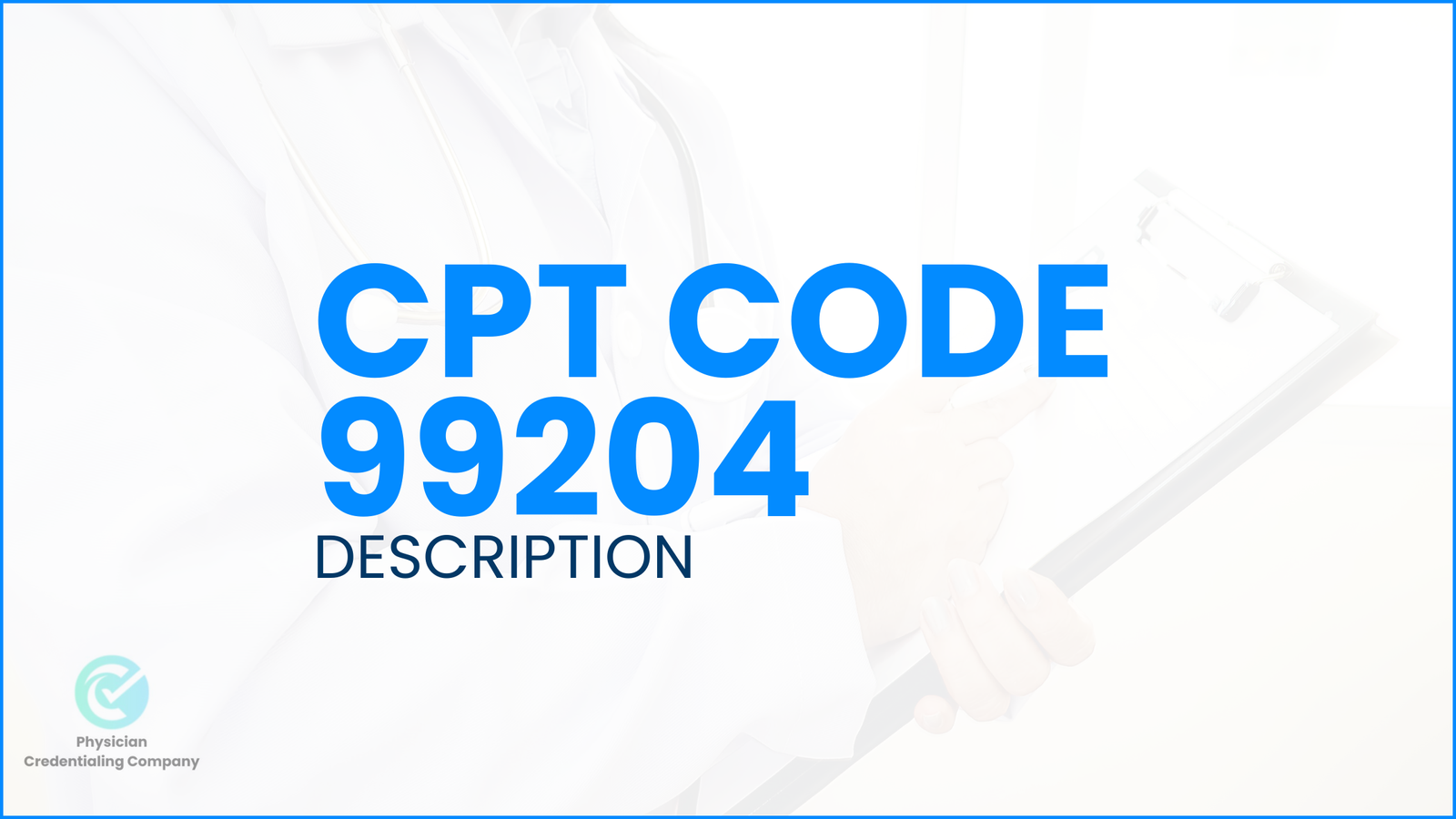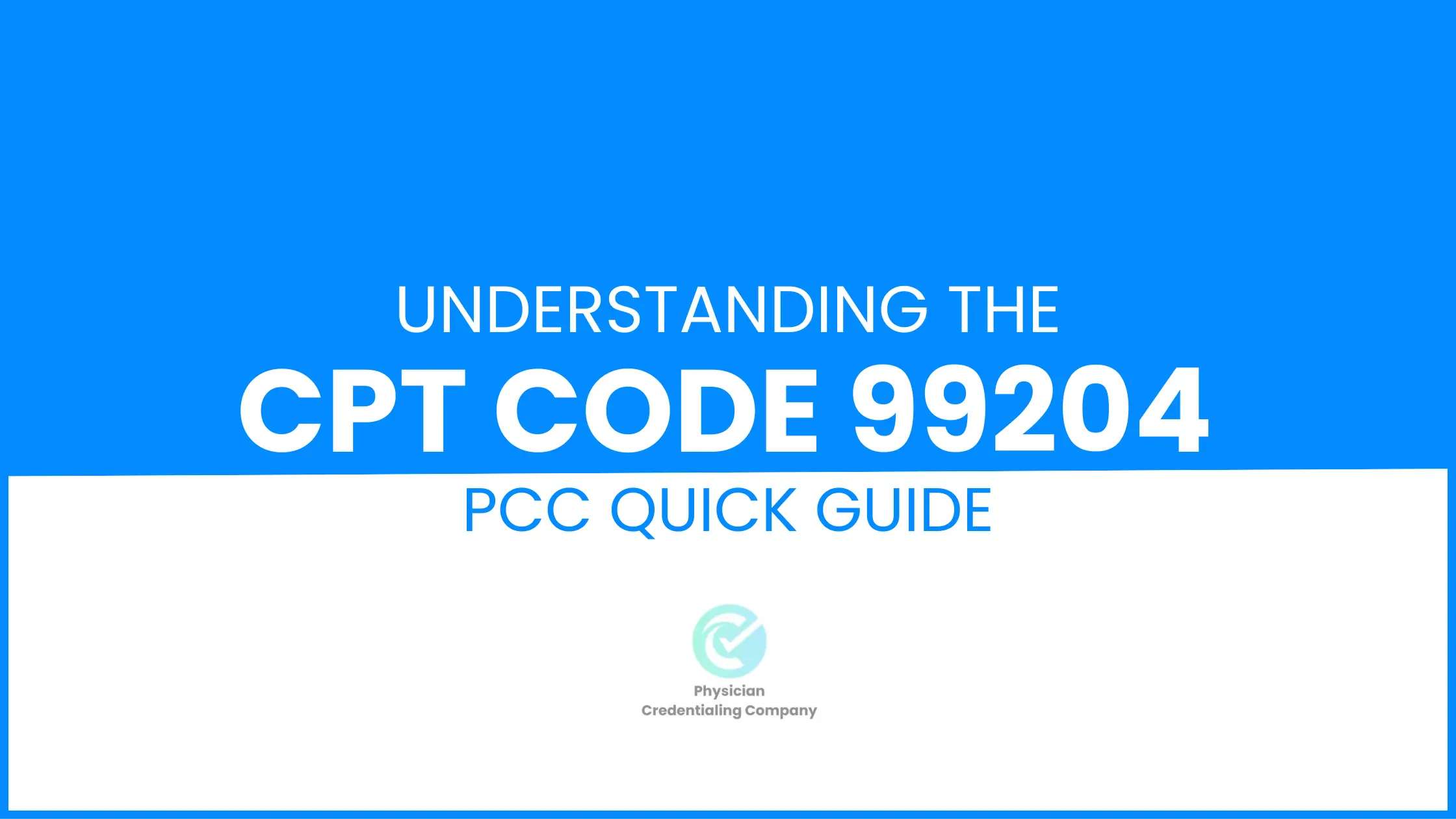Medical billing and coding are the cornerstone of maintaining financial stability in the healthcare sector. It is reported that in the year 2023, about 50% of claims are denied by insurance companies due to errors or not complying with policies. This is really an alarming sign for healthcare professionals who want to grow financially. Medical services are mentioned in the form of CPT codes in the medical bills. CPT codes act as a bridge between the payers and healthcare professionals.
Any error or omission in the legal billing process can lead to claim denials. Understanding the complete process of CPT code billing is essential to avoid errors and denials. In the evaluation and management service, CPT code 99204 holds significant importance. We need to understand how to bill for 99204 to get reimbursement on time.
In this PCC guide, we will learn about the CPT 99204 description, common challenges providers face in the billing process, and the types of services covered by this code. We will also discuss the types of CPT codes and their importance.
Understanding of CPT Codes
Before the 1960s, medical services were described in the medical bills, and there was no universal description of rendered services. Therefore, it created confusion between payers and providers, leading to claim denials and financial loss. This was very daunting for the healthcare professionals to get reimbursement for the services they provide. In order to solve that problem, imposing universality was very important. For that reason, CPT codes were introduced by the AMA in 1966 to improve the medical billing system. Each medical service is specified by one CPT code. The covered services by each CPT code are universal and known by all parties in the healthcare industry.
CPT codes are a standardized set of codes aiming at improving the efficiency of the medical billing system. It has 3 major categories, and all healthcare professionals should know about the CPT codes in each category.
Category 1: This category holds the majority of CPT codes, and this is considered a large body of code. Each code has five characters, and they are described in numerical order. Numerical order gets disturbed if new code is introduced. Evaluation and management codes are most reported in healthcare, and they also belong to this category. Due to greater use, they are listed at the top of category 1 codes. These codes start with the number 9. Below are a few major sections of this category:
- Evaluation and management.
- Radiology procedures.
- Pathology and laboratory procedures.
- Medicine services and procedures.
Category 2: They are nonbillable, supplemental codes used to track the patient’s information, whether they are diabetic or not, smoke or not, etc. These codes help the providers to render the best possible medical services. These codes cover for:
- Composite measures
- Patient management.
- Medical history
- Physical examination
- Diagnostic procedures
- Therapeutic and preventive interventions
- Follow-up and outcomes
- Patient safety
Category 3: Codes in this category are named temporary codes because they remain in this section till their FDA approval and evidence of their wide use by providers. If they meet the criteria of approval in 5 years, they are assigned to category 1. Otherwise, they are removed from this category and coding category for good. These codes bill for new procedures and equipment introduced.
CPT 99204 Description
99204 code refers to the level 4 evaluation and management services provided to new patients on their office or outpatient visits. These visits are often initial and require detailed medical history and examination along with a moderate to high level of medical decision-making (MDM). Time for the visit is often measured, and then the specified code 99204 is applied if it meets the time criteria.
For billing this code, healthcare professionals need to know about the billing procedure and other protocols for billing this code. This code is often used when patients present with some chronic condition or disease with complex symptoms. CPT 99204 level 4 E/M code typically includes four components which need to be fulfilled:

1. Detailed Medical History
On patient presentation, the medical history of the patient is taken to make a probable diagnosis. History has many parts, and it starts with presenting complaints. Complaints with which the patient comes to the doctor are noted. History of presenting illness (HOPI) is the most important part of history in which thorough detail about the presenting complaint is taken by the doctor.
Onset, duration, association, aggravating factor, progression, and relieving factor of the symptom are asked and documented. Each symptom is assessed in the same way, and a systemic review is taken after HOPI. Past medical history, personal history, drug history, and travel history are also parts of a detailed medical history.
2. Medical Examination
Physical examination of all organ systems of the body plays a significant role in evaluating the underlying pathology behind presenting symptoms. One by one, every system of the body is examined for potential findings. It is recommended to follow all examination protocols, i.e., inspection, palpation, percussion, and auscultation. CPT code 99204 refers to the examination of multiple organ systems, starting with a system relevant to a patient’s complaint. All findings are documented as a medical record to provide proof of compliance.
3. Medical Decision Making
Decision-making is not straightforward and simple for CPT code 99204. Moderate to high complexity MDM is the hallmark of this code. All potential history and examination findings, lab reports, and risk factors are evaluated to plan a management for the disease. Differential diagnosis for the disease and associated complications should be kept in mind for management plans. The complex nature of MDM makes this code of high value, and a good reimbursement amount is paid for billing this code.
4. Time Duration
Time plays a significant role along with other components to justify this code. This code typically defines 45-59 minutes of time duration of an office visit. All services are included from patient presentation till the final management plan in this time duration. There is always a need to note and document the time duration of the visit for billing 99204 to payers.
Tips For Accurate Coding And Compliance
Use of Modifier
The modifier is the sub or child code, which is used with the parent code when necessary. If the other services are provided along with E/M services on the same visit within the same healthcare facility, then there is a strong need to use a modifier in medical bills to explain the actual services provided to patients and get reimbursed accordingly.
For instance, CPT code 99204 modifier 25 explains that other healthcare (like wound management) is rendered with E/M service to the patient. Both services are not linked to each other, and they are provided separately, so there is a need for relevant billing and reimbursement.
Documentation & Internal Audits
Subjective and objective documentation makes the billing process transparent, leading to a lower denial rate. Subjective notes include detailed information about each part of the detailed medical history like demographic information, complaints, HOPI, family history, drug history, personal history, and so on. Objective notes include findings of all protocols that are followed to evaluate the condition of the patient during medical examination. All findings are noted, even if they are normal.
Documentation helps to bear all audits which are periodically done by the insurance companies. To check the effectiveness and transparency of the billing system, healthcare professionals must do internal audits. Errors or irregularities detected by internal audits can be managed timely to avoid legal penalties. Claim denials can be reduced, and financial patterns can flourish.
Hire Third Party
If you, as a healthcare professional, are experiencing continuous irregularities in the medical billing process and facing a high denial ratio, then you must hire a third party for billing. Billing is a very complex process. It needs good investment and an expert biller to make the process effective, which seems very impractical for office settings. To avoid all issues, consider hiring a third party. They always have an expert team for the billing process with a track record of minimal claim denial rates. Third parties manage all kinds of claims and provide you with financial stability.
Staying Updated On Coding Guidelines
Coding policies are introduced by the federal or state government and payers periodically to improve the billing process. Healthcare professionals need to remain updated with new policies and regulations to maintain compliance. Rules and regulations from the American Medical Association (AMA) and payers like the Centre of Medicare and Medicaid (CMS) are the ones to be considered carefully. Any violation can lead to claim denial and termination of contract with payers.
General coding guidelines stress documentation and the correct use of code to decrease fraudulent activities. Activities like undercoating to bill at a lower level and overcoming to bill at a higher level than the actual level are not considered legitimate. AMA, CMS, and private insurers have zero-tolerance policies for such mistakes. Healthcare professionals need to take care of such things if they want to grow.
Conclusion
CPT codes are introduced to make the billing process effective and error-free. CPT codes are divided into three main categories. Evaluation and management codes like 99204 lie among the first category. E/M codes are the most used codes in the healthcare industry. Therefore, a complete understanding of these codes is the backbone of success in healthcare. CPT 99204 level 4 E/M code defines the evaluation and management services provided to new patients during office visits of 45-59 minutes. Detailed history, medical examination of multiple organ systems and MDM are included in this code.
All protocols should be filled for using 99204. 99204 is a more reimbursed code than many E/M codes. CPT code 99204 modifier 25 helps to describe the other separate service provided during the same visit. Billing considerations like the use of modifiers, documentation, compliance with policies, and hiring expert billers can lead to fewer claim denials and good revenue generation. Every healthcare professional needs to understand the basics of coding, billing challenges and solutions, reimbursement rates, and the importance of documentation to excel in the healthcare field.
FAQ - People Also Asks
99204 code is used for billing for E/M services provided to new patients during office visits. Visits usually last for 45-59 minutes for this code. Detailed medical history, detailed physical examination, and medical decision-making are the requirements for meeting the criteria for CPT code 99204.
If a patient present with some chronic condition or disease with complex symptoms without straightforward management plans, then 99204 can be used. It is known for its high to moderate complexity of decision-making. Considering risk factors, disease stage, and other evaluations, a management plan is performed to combat disease.
CPT code 99204 is the level 4 evaluation and management code. It is included in the category 1 of CPT codes. E/M codes are listed on top because of their high use in the healthcare industry. Its reimbursement rate for Medicare is $164.93, according to 2021 stats.
CPT code 99204 is utilized for new patient office visits that involve a higher level of complexity and require 45-59 minutes of total time, whereas CPT code 99203 is for visits of moderate complexity requiring 30-44 minutes, reflecting the increased thoroughness and medical decision-making involved in 99204 compared to 99203. You can also read our dedicated blog on 99203 CPT.

